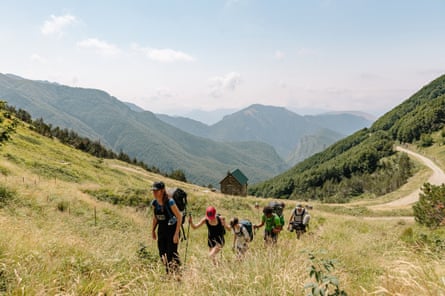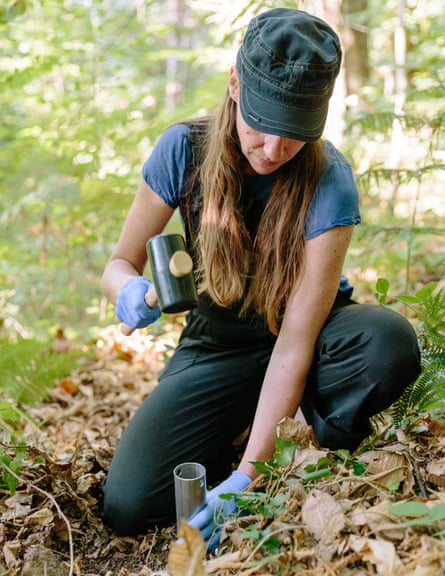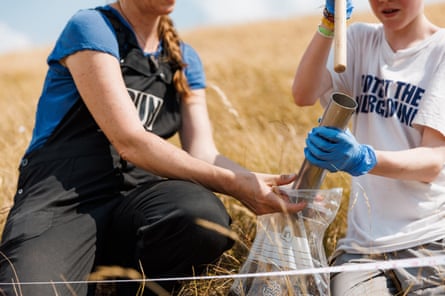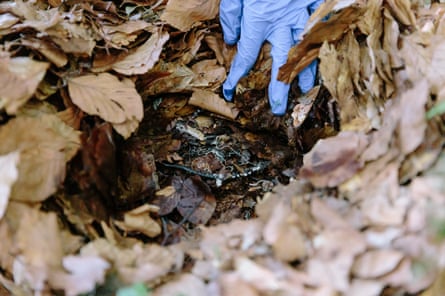When Toby Kiers and a group of fungi experts hiked the Apennine mountains in northern Italy last July, the country was experiencing its worst drought for 70 years. But Kiers, an evolutionary biologist at Vrije Universiteit Amsterdam, saw the dried vegetation and burnt forests of the drought- and fire-stricken areas bordering Tuscany and Emilia-Romagna as a unique learning opportunity.
Armed with rubber mallets, measuring tape and GPS devices, Kiers and her team were investigating a very particular life form: the bustling fungal life beneath their feet.
“What we want to do is track how fungal communities are changing under climate change,” says Kiers. “It will allow us to predict what we need to protect and what we can conserve.”
Kiers was not so interested in mushrooms – the fruiting bodies of fungi, which contain spores and take on myriad shapes and sizes. Instead, she wanted to learn more about the complex fungal systems that live below ground, known as mycorrhizal networks.

Mycorrhizal networks are made up of white, thread-like filaments that many scientists believe play countless ecological roles: they may exchange essential nutrients with trees through the roots, help with the absorption and retention of water, protect plants against pathogens, and hold the soil together by acting as a giant underground net. The thread-like system is so vastly multilayered and interconnected that it is sometimes referred to as the “wood-wide web”.
It’s still unclear if and how these webs help trees flourish, but Kiers believes that studying these underground networks in such stark conditions could help scientists identify drought-resistant fungi that can help crops thrive and shield plants from the consequences of rapidly rising temperatures.
“These fungi can act as ‘biofertilisers’ – they take in phosphorus, nitrogen, potassium, and give it to the plant,” says Paola Bonfante, former professor of plant biology at the University of Turin.

The research could also help scientists anticipate how fungal communities may adapt to climate change in regions susceptible to droughts and fires. Many European countries – including Spain, Greece and Portugal – as well as other parts of the world experienced devastatingly hot summers last year, with raging fires and unusually long droughts.
The initiative is part of a broader project by the Society for the Protection of Underground Networks (Spun) to collect more than 10,000 samples of fungi from across the globe. As executive director of Spun, Kiers is working with GlobalFungi and the Crowther Lab to use satellite and big-data analyses to identify biodiversity hotspots where they can sample these mycorrhizal networks.
Mycorrhizal networks often develop unique relationships with specific species of trees and ecosystems, and in Italy the team took samples near various trees, including pine, beech, chestnut and hazelnut, and in different locations. Samples were also taken in a recently burnt area, and from a similar location nearby that had not been affected by fire, for comparison. An important question is whether mycorrhizal networks were able to withstand the fire and, if so, how that was possible, says Kiers.
To take the samples, the team hammered cylindrical tubes into the soil-containing mycelium – the thin, white strands that constitute a mycorrhizal network – and poured the contents into plastic bags, mixing them thoroughly. Subsamples were then put into plastic tubes and labelled with the geographic coordinates.
In the future, Kiers hopes to return to these sites and compare them with those in more temperate ecosystems. “We want to come back in a year, in two years, and resample and try to understand and look at the recovery process,” she says.

In the meantime, the samples have been sent to Matteo Chialva and Prof Luisa Lanfranco, plant biologists at Turin University. They will conduct genetic sequencing tests that will “allow us to know what organism was present underground”, says Chialva.
Of the estimated 2.2-3.8m species of fungi on Earth, only about 600 have been evaluated for the IUCN’s Red List of Threatened Species. Of these, about half are considered threatened.
“We’re definitely worried,” says Kiers. “The ultimate goal is to really focus on underground biodiversity and be able to say: this is valuable diversity as well.”
Kiers hopes the findings will tell researchers which genes lend fungi their drought-resistant properties and which molecular mechanisms enable them to be resilient.
Scientists already know that some mycelium have flame-retardant properties and others become more efficient at storing water and nutrients when under stress. They also know that mycorrhizal fungi that tend to mingle with crops are probably more resistant to drought than ones that associate with the roots of large forest trees, says Bonfante.
In Antarctica, one fungus, Cryomyces antarcticus, stores high quantities of melanin in its cell wall. Melanin, the same pigment that makes human skins more or less dark and protects against ultraviolet radiation, can protect fungi from drought and fire, says Dr Claudia Coleine, a microbiologist at the University of Tuscia, in Viterbo, near Rome, who studies organisms living in extreme environments and was not involved in the project.
“We’re starting to understand different molecular mechanisms that allow fungi to survive in extreme conditions,” she says.

Bonfante emphasises that laboratory tests alone will not be enough. “We know a lot about fungi, but mostly what happens inside a petri dish,” she says.
Mycorrhizal networks are so deeply interconnected with trees, plants, microbes and other organisms that studying them in isolation means our understanding is limited. Scientists will need to bridge the gap between these two realms by validating their findings in natural settings, she adds.
Kiers agrees. “If we don’t understand what is going on underground and how they’re influencing what we do care about, like chestnut trees and flowers and bees and honey, we’re just missing such a huge part of the picture.”
Find more age of extinction coverage here, and follow biodiversity reporters Phoebe Weston and Patrick Greenfield on Twitter for all the latest news and features




